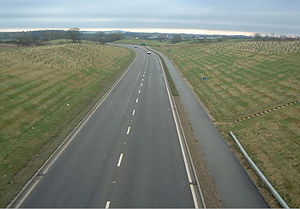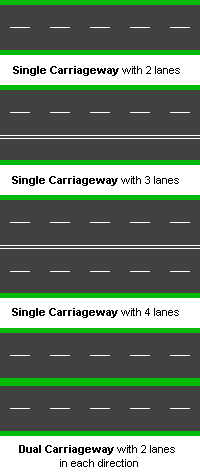
Single carriageway
Encyclopedia

Road
A road is a thoroughfare, route, or way on land between two places, which typically has been paved or otherwise improved to allow travel by some conveyance, including a horse, cart, or motor vehicle. Roads consist of one, or sometimes two, roadways each with one or more lanes and also any...
with 1, 2 or more lane
Lane
A lane is a part of the roadway within a road marked out for use by a single line of vehicles in such a way as to control and guide drivers for the purpose of reducing traffic conflicts. Most public roads have at least two lanes, one for traffic in each direction, separated by Lane markings...
s arranged within a single carriageway
Carriageway
A carriageway consists of a width of road on which a vehicle is not restricted by any physical barriers or separation to move laterally...
(North American English: roadway) with no central reservation
Central reservation
On divided roads, such as divided highways or freeways/motorways, the central reservation , median, parkway , median strip or central nature strip is the area which separates opposing lanes of traffic...
(North American English: median) to separate opposing flows of traffic. Two-lane road or two-lane highway are single carriageway with one lane for each direction. A single-track road has a single lane with passing places for traffic in both directions. Road traffic safety is generally worse for high-speed single carriageway roads than for dual carriageway
Dual carriageway
A dual carriageway is a class of highway with two carriageways for traffic travelling in opposite directions separated by a central reservation...
(North America English: divided highways), due to the lack of separation between traffic moving in opposing directions.
Ireland
The term single carriageway is used for roads in the Republic of IrelandRepublic of Ireland
Ireland , described as the Republic of Ireland , is a sovereign state in Europe occupying approximately five-sixths of the island of the same name. Its capital is Dublin. Ireland, which had a population of 4.58 million in 2011, is a constitutional republic governed as a parliamentary democracy,...
. Speed limits
Road speed limits in the Republic of Ireland
Road speed limits in the Republic of Ireland apply on all public roads in the country. These are signposted and legislated for in kilometres per hour. Speed limits are demarcated by regulatory road signs . These consist of white circular signs with a red outline. Speed limits are marked in black...
on single carriageway roads vary depending on their classification: national primary road
National primary road
A national primary road is a road classification in the Republic of Ireland. National primary roads form the major routes between the major urban centres. There are over 2,700km of national primary roads. This category of road has the prefix "N" followed by one or two digits...
s and national secondary road
National secondary road
A national secondary road is a category of road in Ireland. These roads form an important part of the national route network, but are secondary to the main arterial routes which are classified as national primary roads. National secondary roads are designated with route numbers higher than those...
s have a general speed limit of 100 km/h (62.1 mph), while regional road
Regional road
A regional road in Ireland is a class of road not forming a major route , but nevertheless forming a link in the national route network. There are over 11,600 kilometres of regional roads. Regional roads are numbered with three digit route numbers, prefixed by "R" A regional road in Ireland is a...
s and local roads
Local Roads in Ireland
A Local Road in Ireland is a class of public road not classified as a National road or as a Regional road but nevertheless forming a link in the national network of roads...
have a general speed limit of 80 km/h (49.7 mph). In urban areas, the general speed limit is 50 km/h (31.1 mph).
United Kingdom

Road speed limits in the United Kingdom
Road speed limits in the United Kingdom are used to define the maximum legal speed limit for road vehicles using public roads in the UK, and are one of the measures available to attempt to control traffic speeds. The speed limit in each location is indicated on a nearby traffic sign or by the...
for single-carriageway roads is lower than the maximum for dual-carriageway roads. The 'national speed limit', which is lower for built-up areas, only applies in places where a lower numeric speed limit is not in place. The UK has one major single-carriageway motorway, the A38(M), but a number of link roads at motorway interchanges are single carriageway.
United States
In the U.S. the expression "undivided highway" is likely to mean a multi-lane road with only striping (but no median) between the two directions of traffic flow. A road with two lanes of traffic moving in opposite directions is specifically called a two-lane road.In keeping with the U.S. Department of Transportation's of Uniform Traffic Controls and Devices (MUTCD), since the early 1970s all numbered highways in the U.S. are striped by color to show the direction of traffic flow. Two-way undivided roads have an amber center line (and, if there are baseline shoulder stripes, they are solid white on both sides). This center line may be solid, broken, or a combination of the two, with the different styles denoting whether passing
Overtaking
Overtaking or passing is the act of one vehicle going past another slower moving vehicle, travelling in the same direction, on a road. The lane used for overtaking another vehicle is almost always a lane further from the road shoulder — that is, to the left in places that drive on the right,...
(which requires a driver to move into the lane used by oncoming traffic) is permitted at a given location. But multilane roads use broken white lines between lanes moving in the same direction; at least one solid amber line lies to the left of the lane which borders traffic moving in the opposite direction, and the right sideline is solid white. Drivers can always tell the direction of traffic flow by looking at the striping coloration.
Undivided highways with two-way left turn lanes
Since successful experiments in the late 1960s, some urban undivided highways in the U.S. have had a "neutral" (used by both directions of flow) left-turn lane. This configuration is called a two-way left turn lane (TWLTL, often pronounced "twittle"). Essentially, this configuration puts a turning lane in the position of where a median would be if the road was divided. These roads almost always have an odd number of lanes overall, usually five (two lanes in each direction with a middle turning lane used by both directions of flow), but three-lane and seven-lane versions are not uncommon. TWLTLs are most frequently built in suburban commercial areas where there are a large number of closely spaced driveways (or minor streets).State laws typically require drivers using the center left-turn lane to use signals, to drive slowly in that lane, and to use it solely for turning left. Operationally TWLTLs can be troublesome if the left-turn demand exceeds the amount of storage that can be accommodated in the center lane. Operational problems can also occur if there is limited visibility due to curvature or terrain.

